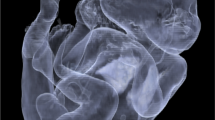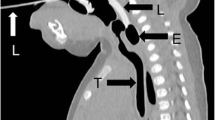Abstract
Through the widespread use of postmortem computed tomography, inner livores of the lungs have become a frequently observed phenomenon in the field of forensic medicine. Yet their time-dependent development, notably in comparison with the widely studied external livores, remains poorly understood. We present a unique homicide case where the victim was discovered in supine position with correspondent external livores fixed exclusively on the rear side. Yet upon postmortem computed tomography, the victim presented pronounced inner livores within the depending dorsal areas of both lungs but also vertical sedimentation levels solely within the right lung, suggesting an initial right-hand side position and a postmortem re-positioning of the body. Interestingly, this was consistent with tangible hints of postmortem manipulation on-site. It is likely that this repositioning occurred sometime during the early postmortem interval (<6 h) as the external livores have completely rearranged to the final supine position. The presented case suggests different development patterns of inner and outer livores, highlighting the necessity for controlled studies that explore the formation and fixation processes of livor mortis in internal organs. A better understanding of these issues can prove useful in forensic examinations.



Similar content being viewed by others
References
Shiotani S, Kohno M, Ohashi N, Yamazaki K, Itai Y (2002) Postmortem intravascular high-density fluid level (hypostasis): CT findings. J Comput Assist Tomogr 26(6):892–893
Henssge C, Madea B, Gallenkemper E (1988) Death time estimation in case work II. Integration of different methods. Forensic Sci Int 39(1):77–87
Henssge C, Madea B (2004) Estimation of the time since death in the early post-mortem period. Forensic Sci Int 144(2–3):167–175. doi:10.1016/j.forsciint.2004.04.051
Sannohe S (2002) Change in the postmortem formation of hypostasis in skin preparations 100 micrometers thick. Am J Forensic Med Pathol 23(4):349–354. doi:10.1097/01.PAF.0000035256.06980.C8
Noriko T (1995) Immunohistochemical studies on postmortem lividity. Forensic Sci Int 72(3):179–189
Thomsen H, Kaatsch HJ, Krisch B (1999) How and why does the platelet count in postmortem blood change during the early postmortem interval? Forensic Sci Int 101(3):185–194
Stammers AH, Vang SN, Mejak BL, Rauch ED (2003) Quantification of the effect of altering hematocrit and temperature on blood viscosity. J Extra Corpor Technol 35(2):143–151
Thali MJ, Yen K, Schweitzer W, Vock P, Boesch C, Ozdoba C, Schroth G, Ith M, Sonnenschein M, Doernhoefer T, Scheurer E, Plattner T, Dirnhofer R (2003) Virtopsy, a new imaging horizon in forensic pathology: virtual autopsy by postmortem multislice computed tomography (MSCT) and magnetic resonance imaging (MRI)—a feasibility study. J Forensic Sci 48(2):386–403
Jackowski C, Schweitzer W, Thali M, Yen K, Aghayev E, Sonnenschein M, Vock P, Dirnhofer R (2005) Virtopsy: postmortem imaging of the human heart in situ using MSCT and MRI. Forensic Sci Int 149(1):11–23. doi:10.1016/j.forsciint.2004.05.019
Jackowski C, Thali M, Aghayev E, Yen K, Sonnenschein M, Zwygart K, Dirnhofer R, Vock P (2006) Postmortem imaging of blood and its characteristics using MSCT and MRI. Int J Legal Med 120(4):233–240. doi:10.1007/s00414-005-0023-4
Klein WM, Bosboom DG, Koopmanschap DH, Nievelstein RA, Nikkels PG, van Rijn RR (2015) Normal pediatric postmortem CT appearances. Pediatr Radiol 45(4):517–526. doi:10.1007/s00247-014-3258-8
Author information
Authors and Affiliations
Corresponding author
Rights and permissions
About this article
Cite this article
Brenčičová, E., Baglivo, M., Schwendener, N. et al. The truth lies within: the reconstructive value of inner livores in a homicide case. Int J Legal Med 130, 1599–1601 (2016). https://doi.org/10.1007/s00414-016-1386-4
Received:
Accepted:
Published:
Issue Date:
DOI: https://doi.org/10.1007/s00414-016-1386-4




